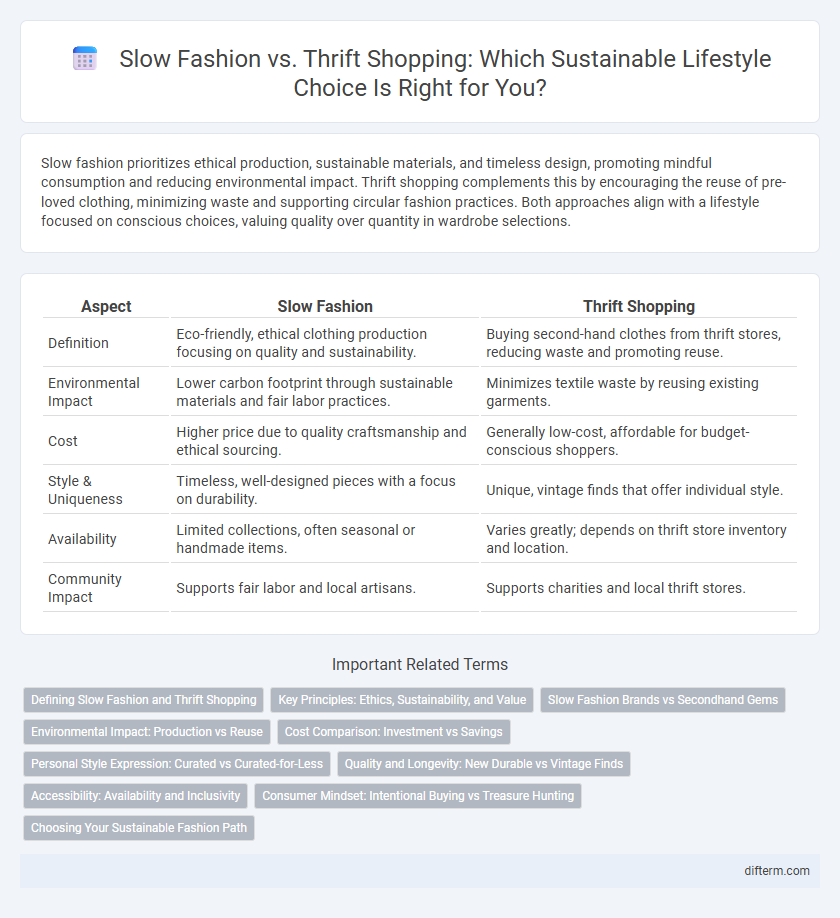Slow fashion prioritizes ethical production, sustainable materials, and timeless design, promoting mindful consumption and reducing environmental impact. Thrift shopping complements this by encouraging the reuse of pre-loved clothing, minimizing waste and supporting circular fashion practices. Both approaches align with a lifestyle focused on conscious choices, valuing quality over quantity in wardrobe selections.
Table of Comparison
| Aspect | Slow Fashion | Thrift Shopping |
|---|---|---|
| Definition | Eco-friendly, ethical clothing production focusing on quality and sustainability. | Buying second-hand clothes from thrift stores, reducing waste and promoting reuse. |
| Environmental Impact | Lower carbon footprint through sustainable materials and fair labor practices. | Minimizes textile waste by reusing existing garments. |
| Cost | Higher price due to quality craftsmanship and ethical sourcing. | Generally low-cost, affordable for budget-conscious shoppers. |
| Style & Uniqueness | Timeless, well-designed pieces with a focus on durability. | Unique, vintage finds that offer individual style. |
| Availability | Limited collections, often seasonal or handmade items. | Varies greatly; depends on thrift store inventory and location. |
| Community Impact | Supports fair labor and local artisans. | Supports charities and local thrift stores. |
Defining Slow Fashion and Thrift Shopping
Slow fashion emphasizes sustainable, ethical production with a focus on quality, durability, and timeless design, minimizing environmental impact and promoting fair labor practices. Thrift shopping involves purchasing secondhand clothing, offering a cost-effective and eco-friendly alternative by extending the lifecycle of garments and reducing textile waste. Both practices contribute to conscious consumerism by encouraging mindful wardrobe choices and reducing fast fashion consumption.
Key Principles: Ethics, Sustainability, and Value
Slow fashion emphasizes ethical production, prioritizing fair labor practices and environmentally sustainable materials to reduce waste and pollution. Thrift shopping supports sustainability by promoting the reuse and recycling of clothing, extending garment life cycles and decreasing demand for new production. Both approaches offer significant value by encouraging mindful consumption, reducing environmental impact, and fostering a culture of responsible fashion choices.
Slow Fashion Brands vs Secondhand Gems
Slow fashion brands prioritize sustainability by creating high-quality, ethically made garments designed to last, reducing environmental impact through mindful production processes. Secondhand gems offer unique, affordable pieces with a low carbon footprint, promoting the circular economy by extending the life cycle of pre-owned clothing. Both approaches contribute to conscious consumerism, supporting eco-friendly lifestyles and reducing textile waste.
Environmental Impact: Production vs Reuse
Slow fashion emphasizes eco-friendly materials and sustainable production methods that reduce carbon emissions and water usage compared to conventional fast fashion. Thrift shopping extends the lifecycle of clothing by promoting reuse, significantly lowering textile waste and the demand for new garment production. Choosing thrift shopping minimizes environmental degradation by cutting resource consumption and landfill contributions associated with manufacturing new apparel.
Cost Comparison: Investment vs Savings
Slow fashion involves investing in high-quality, durable garments that may have a higher upfront cost but offer long-term savings through longevity and reduced replacement frequency. Thrift shopping provides immediate cost savings by purchasing secondhand items at significantly lower prices, making it an economical choice for budget-conscious consumers. Both approaches contribute to sustainable wardrobe practices by minimizing waste and promoting mindful spending habits.
Personal Style Expression: Curated vs Curated-for-Less
Slow fashion emphasizes personal style expression through carefully curated, high-quality pieces that reflect individual taste and sustainable choices. Thrift shopping offers curated-for-less options by allowing unique, often vintage items to be discovered at affordable prices, supporting creativity within budget constraints. Both approaches prioritize intentional wardrobe selection, but slow fashion leans toward mindful investment while thrift shopping embraces accessible and diverse style curation.
Quality and Longevity: New Durable vs Vintage Finds
Slow fashion emphasizes high-quality materials and craftsmanship designed for durability and long-term use, ensuring garments maintain their integrity over years. Thrift shopping offers vintage finds that often showcase unique styles and robust construction from past eras, providing sustainable options with a history of longevity. Both approaches prioritize quality and longevity, reducing fast fashion waste by extending the lifecycle of clothing through mindful consumption.
Accessibility: Availability and Inclusivity
Slow fashion emphasizes ethical production and sustainable materials but often comes with higher price points, limiting accessibility for many consumers. Thrift shopping offers a more inclusive and affordable option, providing diverse styles and sizes from various brands that cater to a broader audience. Both approaches promote responsible consumerism, yet thrift shopping remains more readily available and budget-friendly for everyday shoppers.
Consumer Mindset: Intentional Buying vs Treasure Hunting
Slow fashion promotes intentional buying by encouraging consumers to prioritize quality, sustainability, and ethical production practices in their purchases. Thrift shopping fosters a treasure hunting mindset, where shoppers seek unique, one-of-a-kind items at affordable prices, often driven by spontaneity and the thrill of discovery. Both approaches reshape consumer behavior, valuing conscious consumption over fast, disposable trends.
Choosing Your Sustainable Fashion Path
Choosing your sustainable fashion path means weighing slow fashion's emphasis on ethically made, high-quality garments against thrift shopping's focus on reusing pre-loved items. Slow fashion supports brands that prioritize fair labor practices and eco-friendly materials, reducing overall environmental impact through durability. Thrift shopping extends clothing life cycles by lowering demand for new production, making it a cost-effective and eco-conscious alternative for reducing textile waste.
slow fashion vs thrift shopping Infographic

 difterm.com
difterm.com